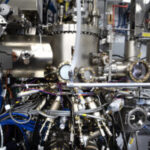2023-03-13 ドイツ連邦共和国・ドレスデン工科大学(TU Dresden)

・ TU Dresden が、渦鞭毛藻類の単細胞生物である Leonella granifera の細胞壁をテンプレートとして利用した、ペロブスカイトナノ構造の製造技術を開発。
・ ペロブスカイトは、その卓越した電気的、光学的、光子的特性から様々なアプリケーションに注目される材料。太陽エネルギー、センシング、光触媒やレーザー等の分野に革新をもたらす可能性が期待されている。
・ ペロブスカイトでは、結晶構造の配列、配向、化学組成や内部構造を変えることでアプリケーションに合わせた特性の調整が可能だが、現行の材料製造方法ではそれが著しく制限される。
・ 単細胞生物は、温度、pH や機械的なストレス等の多様な環境要因に数億年をかけて適応し、自然にしか観られない極めて特殊なバイオマテリアルを形成するように進化している。生きた有機物が形成する鉱物は、現行のペロブスカイト製造技術では再現不可能な構造的・結晶学的な特性を備えている。
・ 新技術では、オランダ・AMOLF 研究所開発のイオン交換/挿入反応プロセスを利用し、L. granifera の放射状結晶構造のカルサイト殻の化学物質を置き換え、多様なナノ構造で機能調整が可能なハロゲン化物ペロブスカイトを作製する。
・ ヨウ素(I)、臭素(Br)または塩素(Cl)のいずれかを含み、赤色、緑色または青色のみに発光するように最適化したペロブスカイトを作製し、単細胞生物の形成する鉱物の機能的な材料への変換を初めて実証した。
・ 新技術はスケールアップが可能。特殊な形状や結晶特性の機能性材料の製造における、藻類やカルサイトを形成する他の単細胞生物活用の可能性が広がる。
・ 本研究には、自然の 3D ナノ構造をベースとした革新的で環境に優しい材料と技術を開発する Free State of Saxony(ザクセン州) の支援する、DinoLight Initiative が資金を提供した。
URL: https://tu-dresden.de/tu-dresden/newsportal/news/scientists-transform-algae-into-unique-functional-perovskites-with-tunable-properties?set_language=en
<NEDO海外技術情報より>
関連情報
Advanced Science 掲載論文(フルテキスト)
Recruiting Unicellular Algae for the Mass Production of Nanostructured Perovskites
URL: https://onlinelibrary.wiley.com/doi/10.1002/advs.202300355
Abstract
Functional capacities of lead halide perovskites are strongly dependent on their morphology, crystallographic texture, and internal ultrastructure on the nano- and the meso-scale. In the last decade, significant efforts are directed towards the development of novel synthesis routes that would overcome the morphological constraints provided by the physical and crystallographic properties of these materials. In contrast, various living organisms, such as unicellular algae, have the ability to mold biogenic crystals into a vast variety of intricate nano-architectured shapes while keeping their single crystalline nature. Here, using the cell wall of the dinoflagellate L. granifera as a model, sustainably harvested biogenic calcite is successfully transformed into nano-structured perovskites. Three variants of lead halide perovskites CH3NH3PbX3 are generated with X = Cl−, Br− and I−; exhibiting emission peak-wavelength ranging from blue, to green, to near-infrared, respectively. The approach can be used for the mass production of nano-architectured perovskites with desired morphological, textural and, consequently, physical properties exploiting the numerous templates provided by calcite forming unicellular organisms.



